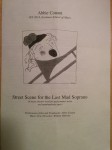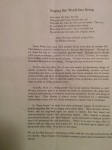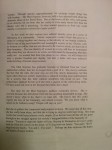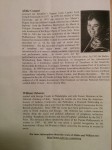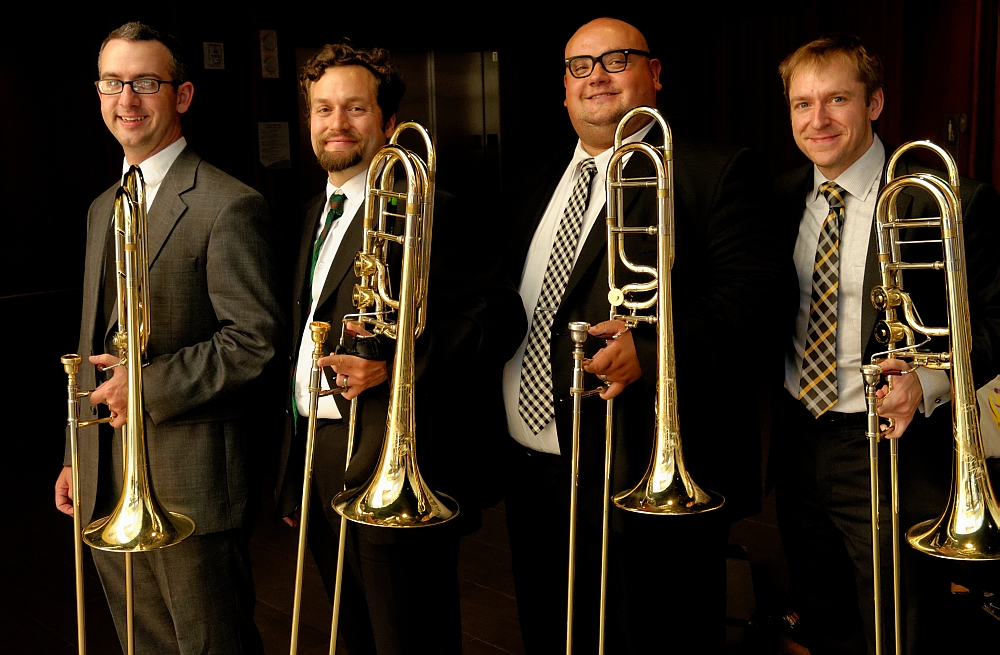The San Francisco Conservatory of Music has shared a video of my presentation at the New Music Gathering.
New Music Gathering 2015
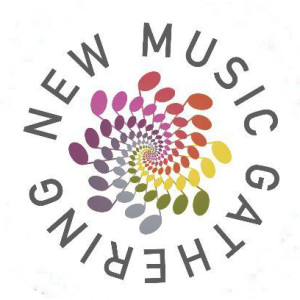
From January 15-17, 2015 New Music Gathering took place at the San Francisco Conservatory of Music. Performers, composers, educators, administrators and fans gathered to discuss everything from engaging the community to the economics of the industry to where to go for the best burrito in the Mission District.
I arrived Friday evening after much of the first day activities (which included what I heard was a fantastic key note address by Claire Chase), but still managed to see and participate in an incredible number of discussions and performances.
Stories of Established Ensembles
The first event I was able to catch was an evening panel discussion entitled “Stories of Established Ensembles”; Sidney Chen and Christina Johnson (of the Kronos Performing Arts Association), Claire Chase (of ICE), and Gavin Chuck and Matt Marks (of Alarm Will Sound) were on stage. Matt moderated the conversation. They each told a bit of the histories of their ensembles and where they are today.
– Alarm Will Sound arose from OSSIA, a student ensemble that Gavin Chuck and Alan Pierson, along with four others, put together at the Eastman School of Music. After completing their degrees they wanted to continue putting together adventurous programs with the people from that group. They also saw a gap in the United States: most every country in Europe has an ensemble devoted to contemporary music. There was no such group in the US.
– ICE came from a proposal Claire Chase made while at Oberlin. From what I understood of her explanation: She formed the idea for a concert event that included educational elements, live performance and recordings. She was told that she should trim back the vision and propose just one thing. “I couldn’t imagine it not being everything.” So she made her proposal as she had originally envisioned and began the mission of ICE.
– Kronos started when David Harrington heard George Crumb’s Black Angels and decided he wanted to play it. He found three other musicians. They moved from Seattle to San Francisco. Sidney talked about the group considering a move to NYC from time to time but always electing to stay in SF because it was part of who they are.
AWS and ICE talked about their current projects: Alarm Will Sound – Alarm System; ICE – OpenICE. There was a question from the audience about the best way to teach entrepreneurship in a college environment. It seemed everyone agreed with Gavin’s answer of “practicum.” “Require students to stage an event, including obtaining equipment and space.” Sidney added, “and give them a budget!”
Composer/Performer Speed Dating
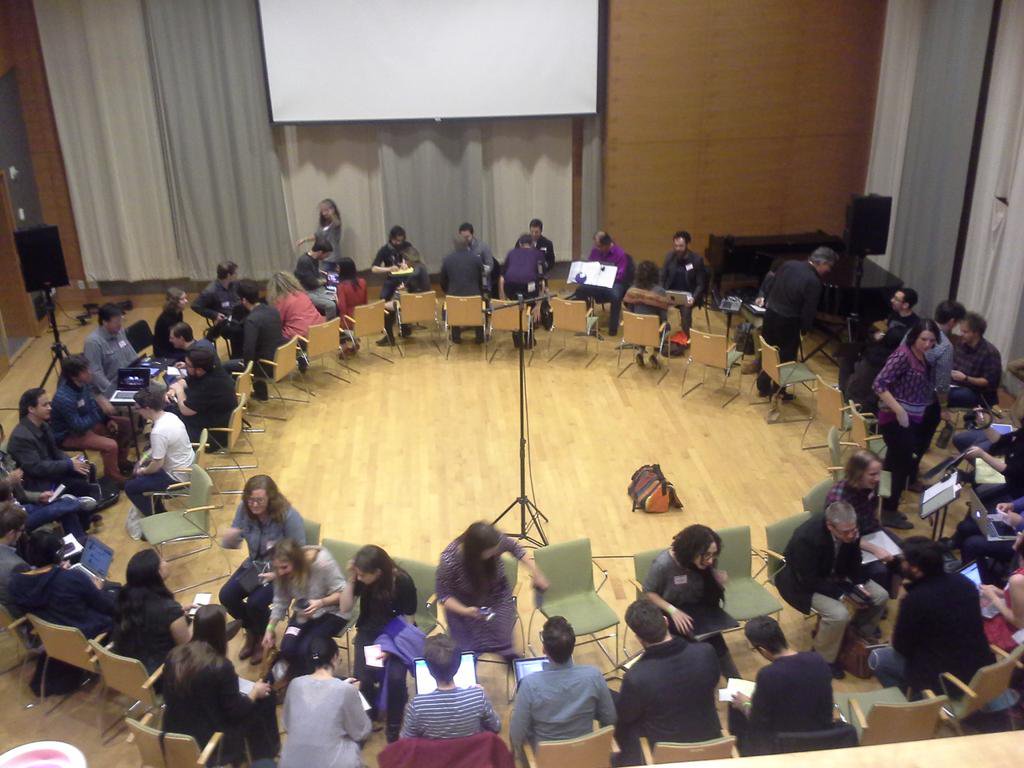
The next event I caught was the morning “Composer/Performer Speed Date.” Great idea, great experience. Composers sat in a circle facing in, performers sat facing them. Performers would rotate every three minutes. It was a great way to make contact and learn a little about one another which may lead to some possible collaborations.
Education Discussion
Daniel Felsenfeld, Kate Sheeran, Brenna Noonan, Pamela Stein and Dan Becker participated in a panel discussion regarding education. They talked about their programs and who they engage. Kate (of the New School at Mannes) talked about The New School Chorus, a community choir that does repertoire from Western choral masterpieces to Eastern European folk singing, classic American jazz and popular song to traditional music. Daniel discussed the NY Philharmonics’ Very Young Composer program which gives students, grades 3-5, the opportunity to write music.
The tendency for students to hide their taste for pop music also came up. Kate remarked how it’s funny how a high school age student will be playing their favorite song from the radio on the piano but immediately stop when a teacher walked past. Where was this hesitancy born? The “stodginess” of teachers? There was general agreement that schools could be more open to all styles.
A Rising Tide: Using Social Media to Grow a Global Audience for New Music
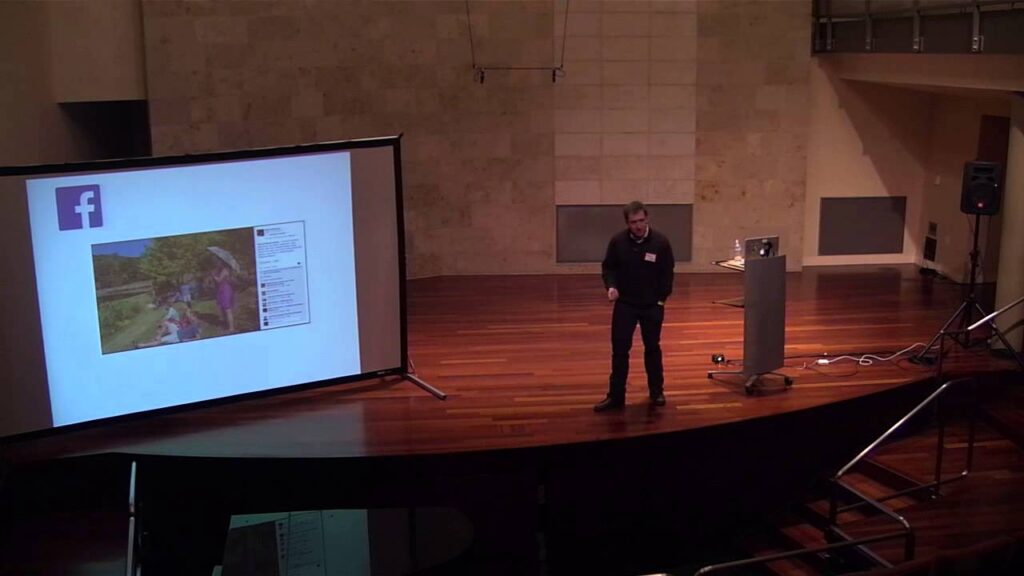
I then gave a presentation on using social media from within a performer-led ensemble and how we as a “new music” community could use social media to grow an audience for all of us. The crux of it: talk about things other than ourselves to get people interested, use the networks with some knowledge of how they operate, celebrate contemporary music as an experience and market that. There was more and there were good questions from those in attendance including Annie Phillips and Matt Marks.
Concert: Joo Won Park
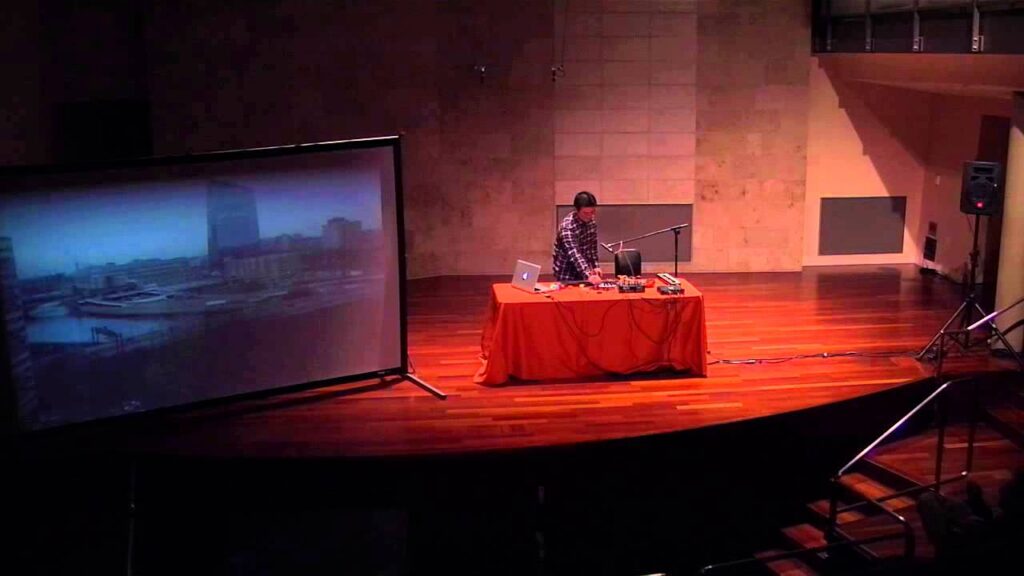
Then I saw a fantastic performance by Joo Won Park. The composer/performer used everything from legos to chains to squeaky toys to a melodica and much more, all routed through SuperCollider to create a fantastic sound experience. The music was varied with moments of serene peacefulness and moments of near overwhelming tension. His pieces incorporated video from time to time, at times showing a closeup of how he was manipulating the objects in front of him, sometimes showing a city skyline with traffic in fast-motion through the course of the day (that image was overlaid with others, creating a dreamy/hallucinogenic effect).
New Music USA and Curing Baumol’s Cost Disease
I arrived late to Kevin Clark’s packed talk. When I entered someone was asking, “so what do we do if the robots take over all the jobs?” Apparently Kevin was discussing the increasing automation (and cost reduction) of certain jobs in the music business (recording, publishing, PR). The discussion was a lively one with questions about “is there such thing as too much new music?” and Eve Beglarian drawing a diagram showing what she sees to be the principle aspects of the performers’ and composers’ jobs:
 She points out the similarities between what each must do and how that “Book” and “Promote” portion of the jobs is the domain of the larger, established corporations. They have connections and distribution.
She points out the similarities between what each must do and how that “Book” and “Promote” portion of the jobs is the domain of the larger, established corporations. They have connections and distribution.
All-in-all it was a far-reaching, engrossing discourse. Cut short, like many of the events of the week, by not enough time.
Unfortunately I had to depart after that missing the panel discussions on women in music, technology and community engagement.
Thanks to the NMG team: Lainie Fefferman, Daniel Felsenfeld, Mary Kouyoumdjian and Matt Marks! The New Music Gathering was a great event and one that I hope to see continue.
ITF 2014 – Rochester, NY
The International Trombone Festival was held at the Eastman School of Music in Rochester, NY this year and I had the good fortune to be able to attend and perform. The festival was packed with events (literally; at times there were as many as five things happening at once) leaving an attendee with a dilemma regarding which to attend. I did my best to catch as much as possible but try as I might I eventually became overwhelmed and needed to catch a breather for a time. What I did see left me inspired, motivated and intrigued. I’ve compiled some of my notes from the event.
First let me thank Newell Sheridan, of Sheridan Brass, for helping make Novus’s appearance at the ITF possible. Check out his website to get a sense of the type of businessman he is, kind of refreshing to see. He stocks only Shires Trombones and his own creation the “Get-a-Grip” hand brace, a very useful tool.
Wednesday June 4
I arrived a bit on the late side and made a bee-line for Abbie Conant‘s performance. I’ve seen her perform once before (in 1998 at Mannes) and her control, endurance, musicianship and creativity made a lasting impression. I was excited to see her again. She performed Street Scene for the Last Mad Soprano, a theatrical work in which her trombone playing is minimalized (but astounding) and her singing and acting ability are brought to the fore.
You can get the concept of the work from the program above. The work is about fifty minutes long and without consistent meter and tonality. Ms. Conant picked pitches out of time and range with ease (check the score to see what she memorized). The musical effect is astounding. It’s a true testament to her musical ability on the trombone and off.
That evening I caught the first half of the Great Lakes Trombone Ensemble performance. Excellent playing, standard repertoire. Took my leave at intermission to work with Mike Selover on the music for our performance on Saturday.
Thursday June 5
Began the day with a warmup on my own and a conversation with Bruce Lee of Facet Mutes. Have to say, those mutes were great. Absolutely great. I’ve written about response problems on other mutes, The Facet Mutes had none of the normal issues. Low to high register they were extremely consistent. I’m confident in recommending them to anyone.
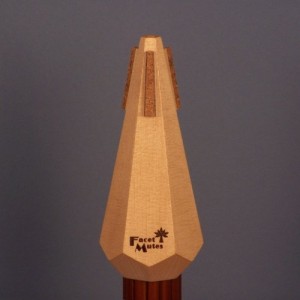
Matt Guilford‘s presentation “Size Matters, but It’s the Little Things That Show How Big You Are!” was next. Matt began his talk with a dramatic reading from Berlioz’s orchestration book, naturally the section regarding the trombone. He then showed how he had notated the text like a musical score with articulations and dynamics.
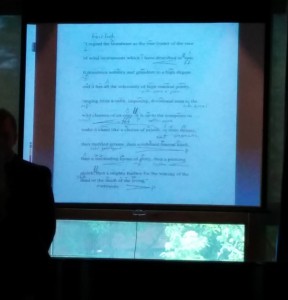
He spoke about how in his (sizable) teaching and playing experience everyone is looking for a “bigger” sound… but these people generally find a good sound and need to start thinking about the “little” things… like articulations and dynamics. He mentioned the value of life experience and how there’s no substitute or way to gain it without living it. He played the opening of the Hindemith Sonata as an example of a piece without expression markings, the Grøndahl Concerto as an example of a piece with lots of markings and the Saint-Saëns Cavatine as an example of a piece with some markings.
The next thing I caught was Ken Thompkins recital. Damn. Ken demonstrated some incredibly controlled, nuanced playing on some varied and difficult repertoire. His performance was in the gigantic Kodak Theater not the easiest space in which to play solo but he did so to great success.

That was it for the day for me. I spent the rest of the evening rehearsing.
Friday June 6
Friday began with the Penn State Trombone Choir and Ken Thompkins’s masterclass on practice strategies. Penn State performed music from Shostakovich’s Festive Overture arrnaged by Mark Lusk and the Verdi Requiem arranged by Brad Snyder, a student in the choir. Mark Lusk, Penn State trombone professor, gave the ensemble empty folders at the beginning of the school year and informed the students that any music they would play that year would be written, arranged or transcribed by them. This piece was a result of that project. Brad arranged the trombone choir in three groups, the largest served as the vocal choir, the orchestra was represented by six trombonists and the vocal solo parts were done by four trombone players.
Ken’s class was on practicing efficiently for success. He stressed organization: use a notebook (note “where you were” and “where you left things”), use a recording device, have all your tools ready to go (metronome, tuner, etc); consistency: practice several hours a day (4 hours plus) in forty-five to sixty minute chunks that include breaks; focus: put aside other things in your life (this can be difficult); slow and steady: approach the music realistically and slowly (look at it first, hear it in your head; going slowly will allow you to begin without bad habits); mental attitude: accept that everyone makes mistakes, that struggle is a sign of growth and development and be sure to acknowledge your successes; have fun: be sure to include something you enjoy in your practice; efficient: you can accomplish quite a bit in three twenty minute sessions (fundamentals, sections of an etude or solo)…
There was a wealth of great material but I ran out at the very end to catch some of John Kenny‘s masterclass. 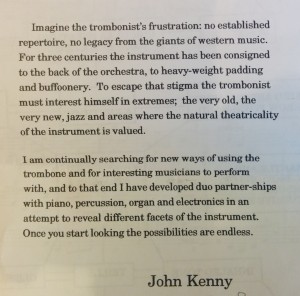
I got there in time to hear John talk about multiphonics and split tones. He talked about the difference between vocal ranges for men and women and how composers should take that into account when writing multiphonics. As for split tones he talked about “finding the click between two harmonics.” He demonstrated by slurring from B flat down to F and stopping when he had both tones simultaneously. One thing he said resonated especially with me: in reference to split tones and strange things in general he said the twentieth century was about “observing things that are not desired and making them desirable.” Seemed pretty dead on to me.
I caught John Kenny’s recital after lunch.

Followed by part of Jörgen van Rijen‘s.
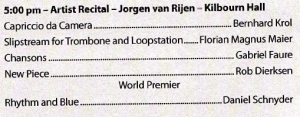 What I saw of Jörgen’s performance was fantastic. Like Abbie Conant I had heard him play years ago (at the ITF in Utrecht in 2000) and was floored. His performance here was just as impressive. It’s great to see and hear someone with fantastic musicality and an interest in doing things outside the traditional repertoire.
What I saw of Jörgen’s performance was fantastic. Like Abbie Conant I had heard him play years ago (at the ITF in Utrecht in 2000) and was floored. His performance here was just as impressive. It’s great to see and hear someone with fantastic musicality and an interest in doing things outside the traditional repertoire.
That evening I rehearsed with the Cramer Choir and got ready for the long day to come.
Saturday June 6
Saturday started with the Cramer Choir led by Jeannie Little. It was truly one of the highlights of my musical career. The group (which is always comprised of trombone professors) this year was made of students of John Marcellus who teach at colleges and universities. It was a stellar group that included:
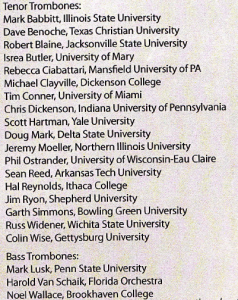 We performed music by Franck and Vollrath and a new work by Kim Scharnberg that was written to celebrate John Marcellus’s career at the Eastman School of Music. For Kim’s piece I did a rendition of the Pledge of Allegiance through the trombone a la Robert Erickson’s General Speech. We finished the concert with the current Eastman students who are graduating with a performance of Ralph Sauer’s new arrangement of the Adagio from Saint-Saëns’s Third Symphony conducted by John Marcellus. Doc was in prime form and his musicality transferred to the ensemble. There were tears. I really hope someone recorded that.
We performed music by Franck and Vollrath and a new work by Kim Scharnberg that was written to celebrate John Marcellus’s career at the Eastman School of Music. For Kim’s piece I did a rendition of the Pledge of Allegiance through the trombone a la Robert Erickson’s General Speech. We finished the concert with the current Eastman students who are graduating with a performance of Ralph Sauer’s new arrangement of the Adagio from Saint-Saëns’s Third Symphony conducted by John Marcellus. Doc was in prime form and his musicality transferred to the ensemble. There were tears. I really hope someone recorded that.
Then came the concert with Novus. We prepared a fifty minute performance with brand new and not-too-old repertoire.
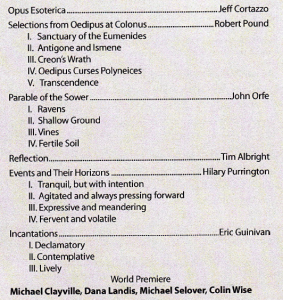
Our performance may have been the only not double-booked for the festival and we had a great audience. Thanks to all who attended. I truly hoped you enjoyed it.
The final concert of the festival was that evening and featured Bret Baker, Ian Bousfield, Matthew Guilford and Jim Pugh performing with the Eastman Wind Ensemble.
Sunday June 7
That wasn’t the end of the trombones. Sunday morning I headed to Riverside Cemetery with about twenty others to pay respects to Emory Remington. In an event organized by Ralph Sauer and Gordon Cherry, trombonists gathered, warmed up, listened to Ralph play the Sarabande from the fifth Bach Cello Suite, played O Sacred Head and the Adagio from Saint-Saëns Third Symphony and listened to stories about “the Chief.” It was an indescribably powerful event, one that I feel fortunate to have participated in. Gordon spoke of Remington’s lasting contribution to creating the trombone “community.” The ITF was definitely an extension of that. The people I met and old acquaintances I reconnected with made the week truly special.
I can’t put into words all that I experienced at the festival but hopefully what I can share is useful to the community.

